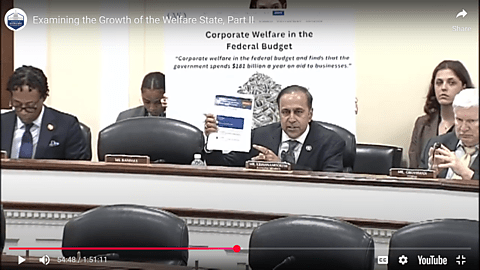
Marc Joffe and Krit Chanwong
California Governor Gavin Newsom’s proposed 2024–2025 budget includes a provision to raise taxes on the state’s Medicaid‐managed care providers. This proposed provider tax will generate nearly $5 billion in net revenue for the California state government. Newsom intends to use this revenue to balance California’s budget, among other goals. Unfortunately, this tax will ultimately cost all US taxpayers because it exploits a Medicaid financing loophole to extract more federal funds.
Under Medicaid, state governments pay providers for healthcare expenditures incurred on behalf of beneficiaries. The federal government then reimburses a percentage of these expenses. The rate at which the federal government reimburses states is based on each state’s per capita personal income. These reimbursement percentages for 2024 are reproduced in Figure 1.
State governments can pay their share through their general tax revenues. Or they can use a wide variety of what healthcare economist Brian Blase calls ‘financing gimmicks’ to pay for their state share. As seen in Figure 2, states are making more use of this latter option.
One type of financing gimmick is a provider tax, under which the state levies a tax on healthcare providers and uses the tax revenue to pay for Medicaid. These taxes attract a federal match and thereby shift more Medicaid costs onto federal taxpayers. As Fig. 3 shows, states usually pay Medicaid providers more than the taxes they extract. States can use some of the extra federal money for other budget priorities.
California’s new provider tax does exactly this. A May 2023 California Legislative Analyst’s Office brief reports that revenue from the Medicaid provider tax “would be used to offset General Fund spending in Medi‐Cal and help address the state’s budget problem.” Another May 2023 primer published by the California Department of Health Care Services states that the tax will be paired with “increases [in] the rates the state pays to Medi‐Cal managed care plans to account for the tax. As such, there is no net impact to Medi‐Cal managed care plans.”
States have been using provider taxes to tie down more federal funds since the 1980s. In 1991, Congress began to crackdown on the use of provider taxes. A 1993 regulation implementing Congress’ stance specified that a provider tax was permissible only if it met the following criteria:
Broad‐Based: A provider tax has to be applied to all providers of the same class. For example, a tax on providers must be applied to both Medicaid and non‐Medicaid providers.
Uniform: A provider tax must be applied at the same rate to all providers of the same class. This means that a provider tax cannot be higher for Medicaid providers than for non‐Medicaid providers.
Hold‐Harmless Ban: A provider tax cannot hold the taxpayer harmless. This means that the taxpayer cannot receive a “pay‐out” back from the state equal to, or exceeding the amount, of the taxes levied.
California’s new provider tax is not broad‐based, since it is only levied on a single tier of California’s Medicaid plans. Moreover, California’s new provider taxes are not uniform. Under the 2024–2025 proposed taxes, Medicaid plans would pay around 94 times more per beneficiary than non‐Medicaid plans. So, it seems that California’s new provider taxes would be impermissible under these regulations.
However, the federal government can waive the broad‐based/uniform requirements if the proposed healthcare tax is “generally redistributive,” i.e. if the tax “derives [Medicaid] revenue from taxes imposed on non‐Medicaid services.” To test whether a tax is “generally redistributive,” the federal government applies a three‐step “B1/B2” test:
B1 Regression: In this baseline linear regression, the percent share of the total tax paid by all taxpayers during a 12‐month period is the dependent variable. The independent variable is the amount of Medicaid taxes a provider has to pay over 12 months if the tax were broad‐based and uniform. The coefficient of this regression is B1.
B2 Regression: In this auxiliary linear regression, the percent share of the total tax paid by all taxpayers during a 12‐month period is the dependent variable. The independent variable is the amount of Medicaid taxes a provider has to pay in the proposed tax plan. The coefficient of this regression is B2.
If the value of B1/B2 is one or greater, then the federal government automatically accepts the tax as being “generally redistributive.”
A linear regression is a technique that yields the best‐fitting straight line between points. The coefficient of the line is called the “slope.” The slope represents how a one‐unit change in the independent variable leads to a one‐unit change in the dependent variable. The main assumption of the B1/B2 test is simple: if two regression lines have similar slopes, then the underlying data must be similar.
A linear regression, however, depends on many assumptions. If these assumptions are not met, then a linear regression will not be a good description of the underlying data. This is why a good chunk of a statistical analyst’s time is spent on trying to verify a linear regression’s assumptions. The B1/B2 test skips this crucial step, incorrectly assuming that similarity in regression slopes implies similarity in the underlying data.
This raises the question of whether the California provider tax conforms to the spirit of the law and regulations. The tax itself is obviously not generally redistributive: almost all the tax revenues are collected on Medicaid plans. However, California’s new provider taxes still passed the B1/B2 test. This shows the folly of using linear regression without any consideration of its theoretical basis.
The federal government now recognizes the flaws of the B1/B2 test. In a letter sent to California’s Medicaid administrator, the federal government states:
The results of the statistical tests, in these instances, do not appear consistent with either the definition of generally redistributive or reflective of the expected results based on the intended design of the statistical test. Therefore, CMS intends to develop and propose new regulatory requirements through the notice‐and‐comment rulemaking process to address this issue.
This change, however, is unlikely to prevent states from finding other ways to exploit loopholes and extract more federal funds. The problem stems from the perverse incentives that are caused by Medicaid’s open‐ended matching structure. As such, the best solution is to eliminate these incentives by turning Medicaid into a block‐grant program. Our colleague, Michael F. Cannon, has written extensively about the many fiscal and health advantages of block‐granting Medicaid.



